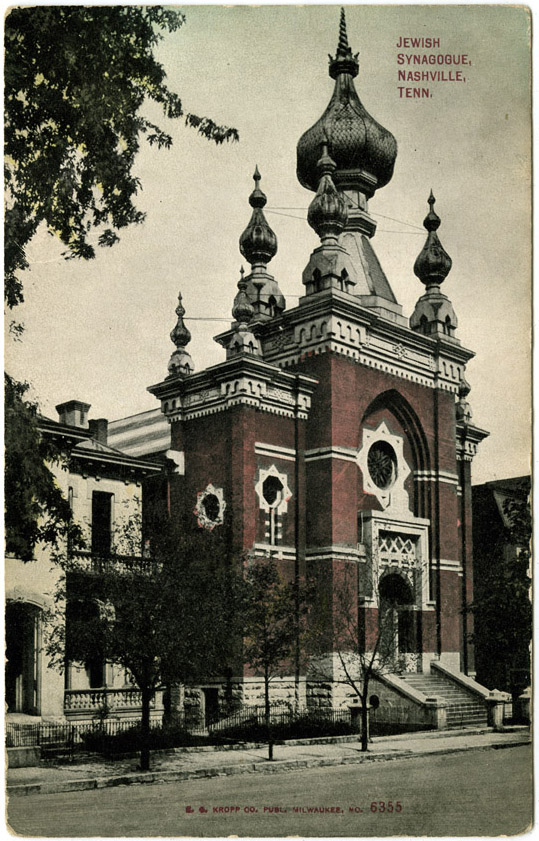4.2 Nashville, Tennessee
Khal Kodesh Ohavai Sholom/Vine Street Temple
Architect unknown, 1876
E. C. Kropp Company, Milwaukee, Wisconsin, publisher; no date
Nashville’s former Vine Street Temple opened its doors to congregants on May 26, 1876. It ranks among the most picturesque—and exotic—of all late-19th-century southern synagogues. The eclectic, fanciful, design featured nine domes in varying sizes, culminating in the 145-foot-high center dome, articulated with overlapping leaves that led to a large gilt crown and scepter.
Inside, the concave ceiling was especially noted for acoustic excellence. The stained glass windows, solid doors, carved walnut furniture, wrought-iron spiral staircases, and towering chandeliers all conveyed a sense of opulence. The carved walnut ark echoed in miniature the building facade.
The 1870s were America’s Gilded Age, and the architectural exuberance of Ohavai Sholom (Lovers of Peace) is in keeping with the innovative decorative tastes of the time, as seen in concert halls, department stores, private mansions, and even in religious architecture, though synagogues tended to experiment more than contemporary churches.
Ohavai Sholom began as a congregation in 1851 when a group of predominantly German-speaking Jews chose a meeting place and established a benevolent society and burial ground. The congregation split in 1861 but reunited in 1867 and took the new name Khal Kodesh Ohavai Sholom (Holy Congregation Lovers of Peace). In 1872, the growing congregation purchased a lot on Vine Street, now 7th Avenue, for $6,200, and the cornerstone of the new temple was laid as part of an elaborate ceremony in August 1874. Former president Andrew Johnson, Tennessee governor John C. Brown, and the esteemed Rabbi Isaac Mayer Wise of Cincinnati were guests of honor. They were greeted by a crowd of more than 1,000 people, who lined the streets to view the procession that made its way from the congregation’s rented space on Market Street (2nd Avenue) to the new building site.
The Vine Street temple, known as “The Hebrew Church,” was a Nashville landmark and symbol of the Jewish community for almost eight decades. By the 1950s, however, most Jews had migrated to West Nashville. When the building needed repairs in 1955, it was sold and razed, to be replaced by a parking structure. The congregation moved to its site at 5015 Harding Pike in the more rural Belle Meade, where it became known as Congregation Ohabai Sholom–The Temple.
